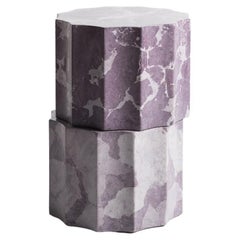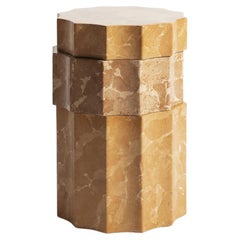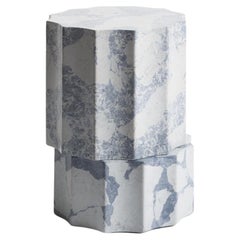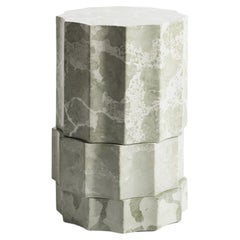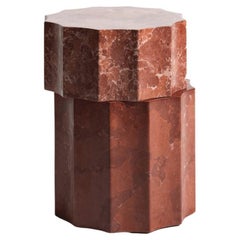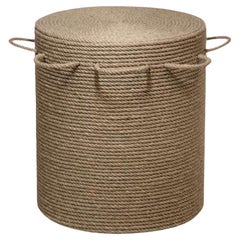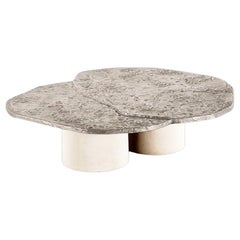Roberto Sironi Stools
to
5
5
Height
to
Width
to
Depth
to
5
5
5
5
5
5
5
33
297
142
117
86
Creator: Roberto Sironi
Domus Pompeii Menandro Stool by Roberto Sironi
By Roberto Sironi
Located in Pireaus-Athens, Greece
Rediscovered in 1748, after being buried for almost two millennia under a blanket of lava and ash following the eruption of Vesuvius, Pompeii redefines our relationship with the past
through its generative potential between reality and imagination.
Defined by Goethe “An incredible place, worthy of peaceful thoughts”, Pompeii has the power to transform inanimate archaeological material into narrative matter, merging past and present in a relationship of reciprocity and interaction.
Exploring the site, today as then, it is possible to admire the interiors decorated with frescoes that reproduce architectural partitions or that tell stories of myths and divinities, in rooms set up with marble elements that the owner used to display his most precious objects.
The Pompeian frescoes were made according to different techniques with colors obtained from earth and minerals such as cinnabar (Pompeian red), ochres (Pompeian yellow), by oxidation processes of metals as in the case of cerulean or by the pulverization of roots and animal bones as in case of greens and blacks.
DOMUS POMPEII is a capsule collection of five side...
Category
2010s Roberto Sironi Stools
Materials
Marble
Domus Pompeii Dioscuri Stool by Roberto Sironi
By Roberto Sironi
Located in Pireaus-Athens, Greece
Rediscovered in 1748, after being buried for almost two millennia under a blanket of lava and ash following the eruption of Vesuvius, Pompeii redefines our relationship with the past
through its generative potential between reality and imagination.
Defined by Goethe “An incredible place, worthy of peaceful thoughts”, Pompeii has the power to transform inanimate archaeological material into narrative matter, merging past and present in a relationship of reciprocity and interaction.
Exploring the site, today as then, it is possible to admire the interiors decorated with frescoes that reproduce architectural partitions or that tell stories of myths and divinities, in rooms set up with marble elements that the owner used to display his most precious objects.
The Pompeian frescoes were made according to different techniques with colors obtained from earth and minerals such as cinnabar (Pompeian red), ochres (Pompeian yellow), by oxidation processes of metals as in the case of cerulean or by the pulverization of roots and animal bones as in case of greens and blacks.
DOMUS POMPEII is a capsule collection of five side...
Category
2010s Roberto Sironi Stools
Materials
Marble
Domus Pompeii Efebo Stool by Roberto Sironi
By Roberto Sironi
Located in Pireaus-Athens, Greece
Rediscovered in 1748, after being buried for almost two millennia under a blanket of lava and ash following the eruption of Vesuvius, Pompeii redefines our relationship with the past
through its generative potential between reality and imagination.
Defined by Goethe “An incredible place, worthy of peaceful thoughts”, Pompeii has the power to transform inanimate archaeological material into narrative matter, merging past and present in a relationship of reciprocity and interaction.
Exploring the site, today as then, it is possible to admire the interiors decorated with frescoes that reproduce architectural partitions or that tell stories of myths and divinities, in rooms set up with marble elements that the owner used to display his most precious objects.
The Pompeian frescoes were made according to different techniques with colors obtained from earth and minerals such as cinnabar (Pompeian red), ochres (Pompeian yellow), by oxidation processes of metals as in the case of cerulean or by the pulverization of roots and animal bones as in case of greens and blacks.
DOMUS POMPEII is a capsule collection of five side...
Category
2010s Roberto Sironi Stools
Materials
Marble
Domus Pompeii Fauno Stool by Roberto Sironi
By Roberto Sironi
Located in Pireaus-Athens, Greece
Rediscovered in 1748, after being buried for almost two millennia under a blanket of lava and ash following the eruption of Vesuvius, Pompeii redefines our relationship with the past
through its generative potential between reality and imagination.
Defined by Goethe “An incredible place, worthy of peaceful thoughts”, Pompeii has the power to transform inanimate archaeological material into narrative matter, merging past and present in a relationship of reciprocity and interaction.
Exploring the site, today as then, it is possible to admire the interiors decorated with frescoes that reproduce architectural partitions or that tell stories of myths and divinities, in rooms set up with marble elements that the owner used to display his most precious objects.
The Pompeian frescoes were made according to different techniques with colors obtained from earth and minerals such as cinnabar (Pompeian red), ochres (Pompeian yellow), by oxidation processes of metals as in the case of cerulean or by the pulverization of roots and animal bones as in case of greens and blacks.
DOMUS POMPEII is a capsule collection of five side...
Category
2010s Roberto Sironi Stools
Materials
Marble
Domus Pompeii Vettii Stool by Roberto Sironi
By Roberto Sironi
Located in Pireaus-Athens, Greece
Rediscovered in 1748, after being buried for almost two millennia under a blanket of lava and ash following the eruption of Vesuvius, Pompeii redefines our relationship with the past
through its generative potential between reality and imagination.
Defined by Goethe “An incredible place, worthy of peaceful thoughts”, Pompeii has the power to transform inanimate archaeological material into narrative matter, merging past and present in a relationship of reciprocity and interaction.
Exploring the site, today as then, it is possible to admire the interiors decorated with frescoes that reproduce architectural partitions or that tell stories of myths and divinities, in rooms set up with marble elements that the owner used to display his most precious objects.
The Pompeian frescoes were made according to different techniques with colors obtained from earth and minerals such as cinnabar (Pompeian red), ochres (Pompeian yellow), by oxidation processes of metals as in the case of cerulean or by the pulverization of roots and animal bones as in case of greens and blacks.
DOMUS POMPEII is a capsule collection of five side...
Category
2010s Roberto Sironi Stools
Materials
Marble
Related Items
Contemporary Poney Stool Designed by Christian Astuguevieille
By Christian Astuguevieille
Located in North Miami, FL
Contemporary poney stool/side table designed by Christian Astuguevieille and made by hand of Natural Hemp Rope.
Category
21st Century and Contemporary Roberto Sironi Stools
Materials
Hemp, Rope
Tacchini Brut Coffee Table by Roberto Sironi in Stock
By Tacchini, Roberto Sironi
Located in New York, NY
LOW TABLE CM.130X110XH.34 -
white CEMENT BASE - ALUMINUM TOP
Art is a spontaneous expression, which dissolves the constraints of traditional culture. The material as a raw element, ...
Category
2010s Italian Roberto Sironi Stools
Materials
Cement, Aluminum
Griffin Stool / Side Table by Phase Design
By Reza Feiz, Phase Design
Located in North Hollywood, CA
Listed price is for the Griffin stool / side table in either walnut, white oak, or ebonized oak.
Prices exclude packing.
This versatile piece works interchangeably as a side table or stool. Made from a hand sanded fiberglass shell and finished with a high-end automotive polyurethane gloss finish, it is lightweight and durable. The 1.5" solid lumber top tempers the clean architectural form with its warm organic...
Category
2010s American Roberto Sironi Stools
Materials
Wood, Oak, Walnut, Fiberglass
Silent Stump, Side Table / Stool by Made by Choice
Located in Geneve, CH
Silent stump, side table / stool by Made By Choice (Seating object, functioning also as a table)
Nordic Silence Collection with Katrín Ólína
Dimensions:...
Category
2010s Finnish Post-Modern Roberto Sironi Stools
Materials
Ash, Cork
Mor Side Table & Stool by Samuel Dos Santos
Located in Geneve, CH
MOR side table & stool by Samuel Dos Santos
Materials: Limestone. Honed finishing.
Dimensions: W 48 x D 48 x H 66 cm
MOR it´s the new side table...
Category
2010s Portuguese Modern Roberto Sironi Stools
Materials
Limestone
Castiglioni Rochetto Stool or Table by Kartell
By Kartell, Achille & Pier Giacomo Castiglioni
Located in Highland, IN
Designed in 1969 by the Castiglioni brothers, the "rochetto", or "spool" stool is a wonderful design. Two identical forms are fastened together giving it the distinctive hourglass sp...
Category
1960s Italian Mid-Century Modern Vintage Roberto Sironi Stools
Materials
Upholstery, Plastic
White 2 Union Stool by Lea Ginac
Located in Geneve, CH
White 2 union stool by Lea Ginac
Unique Piece.
Dimensions: Diameter 23 x Height 47 cm
Materials: Chamotte clay. Handmade Ceramic.
Technique: Hand-modeling.
Available in two o...
Category
2010s French Modern Roberto Sironi Stools
Materials
Ceramic, Clay
A Low Stool by Charlotte Perriand
By Charlotte Perriand
Located in San Francisco, CA
A rare low stool in mahogany with three tapered legs by Charlotte Perriand.
France, circa 1950s. One stool remains available.
Category
1950s French Modern Vintage Roberto Sironi Stools
Materials
Mahogany
Stainless Steel Contemporary Stackable Stool by Johan Viladrich
By Johan Viladrich
Located in Geneve, CH
Contemporary stackable stool by Johan Viladrich.
Material: Anodised aluminum, stainless steel bolts
Measures: L 43, W 20, H 45 cm.
Apprx. 15kg
Limited edition of 200 + 20AP
Th...
Category
2010s Dutch Modern Roberto Sironi Stools
Materials
Stainless Steel
$1,149 / item
H 17.72 in W 7.88 in D 16.93 in
Tacchini Brut Coffee Table by Roberto Sironi in Stock
By Roberto Sironi, Tacchini
Located in New York, NY
LOW TABLE CM.130X110XH.34 -
white CEMENT BASE - ALUMINUM TOP
Art is a spontaneous expression, which dissolves the constraints of traditional culture. The material as a raw element, ...
Category
2010s Italian Roberto Sironi Stools
Materials
Cement, Aluminum
Marble Cross Side Table / Stool by 101 Copenhagen
Located in Geneve, CH
Marble cross side table / stool by 101 Copenhagen
Designed by Kristian Sofus Hansen & Tommy Hyldahl
Dimensions: L 35 / W 35 /H 45 cm.
Materials: marble...
Category
2010s Danish Modern Roberto Sironi Stools
Materials
Marble
Shagreen Fluted Stool by R&Y Augousti
By R & Y Augousti
Located in New York, NY
The fluted stool by R & Y Augousti is a sleek and geometric design. The black pen shell inlaid piece provides comfort while retaining a striking aesthetic...
Category
21st Century and Contemporary French Art Deco Roberto Sironi Stools
Materials
Shell
Roberto Sironi stools for sale on 1stDibs.
Roberto Sironi stools are available for sale on 1stDibs. These distinctive items are frequently made of stone and are designed with extraordinary care. There are many options to choose from in our collection of Roberto Sironi stools, although gray editions of this piece are particularly popular. If you’re looking for additional options, many customers also consider stools by Daishi Luo, Anne Dorthe Vester, and Maria Bruun. Prices for Roberto Sironi stools can differ depending upon size, time period and other attributes — on 1stDibs, these items begin at $6,657 and can go as high as $6,657, while a piece like these, on average, fetch $6,657.
